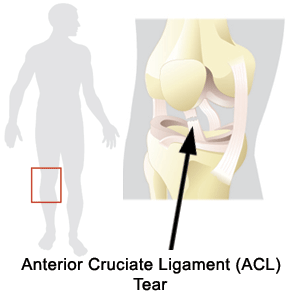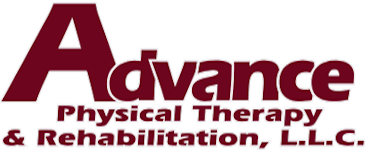Pick a Body Area
Knee Articles- Quadriceps Muscle Strains
- Meniscal Tears
- Anterior Cruciate Ligament (ACL) Tear
- Posterior Cruciate Ligament (PCL) Tear
- Medial Collateral Ligament (MCL) Tear
- Lateral Collateral Ligament (LCL) Tears
- Anterior Knee Pain
- Patello-femoral Pain (Commonly Called Chondromalacia Patella)
- Patellar Tendinitis (Jumper's Knee)
- Knee Osteoarthritis
- Iliotibial Band Friction Syndrome (ITBS)
- Knee Replacement
Anterior Cruciate Ligament (ACL) Tear

The cruciate (or crossing) ligament stabilizes the knee. The anterior cruciate (ACL) may completely break (rupture) when the knee is bent beyond its normal range of motion or with excessive twisting. Signs and symptoms include a ‘pop’ sensation with significant swelling and pain. There is a sense of instability or the knee giving away. Initial treatment includes rest, ice, elevation, and compression. Physical therapy consisting of progressive strengthening and functional exercise may facilitate recovery. If knee instability persists, surgery is indicated. The middle third of the patellar tendon, hamstrings, or cadaver ligament may be used to reconstruct the lost ligament.
ACL tears are common in teenage female athletes. Some of the best clinical/sports medicine research to date, suggests that a preventive training program can significantly reduce the risk of ACL injuries in female adolescent athletes.
Possible Treatments
- Aerobic/Endurance Exercise Video
- Core Strengthening Video
- Cryotherapy or Cold Therapy Video
- Electrotherapeutic Modalities
- Gait or Walking Training Video
- Isometric Exercise Video
- Knee Active Range of Motion Video
- Knee Passive Range of Motion Video
- Neuromuscular Electrical Stimulation Video
- Proprioception Exercises Video
- Physical Agents
- Soft Tissue Mobilization Video
- Stretching/Flexibility Exercise Video
- Aerobic/Endurance Exercise
Possible Treatment Goals
- Improve ability to bear weight/stand on the leg(s)
- Decrease Risk of Reoccurrence
- Improve Fitness
- Improve Function
- Improve Muscle Strength and Power
- Increase Oxygen to Tissues
- Improve Proprioception
- Decrease Postoperative Complications
- Improve Range of Motion
- Self-care of Symptoms
- Improve Safety
- Improve Tolerance for Prolonged Activities
- Improve Wound Healing
Additional Resources
Disclaimer
The information in this medical library is intended for informational and educational purposes only and in no way should be taken to be the provision or practice of physical therapy, medical, or professional healthcare advice or services. The information should not be considered complete or exhaustive and should not be used for diagnostic or treatment purposes without first consulting with your physical therapist, occupational therapist, physician or other healthcare provider. The owners of this website accept no responsibility for the misuse of information contained within this website.
